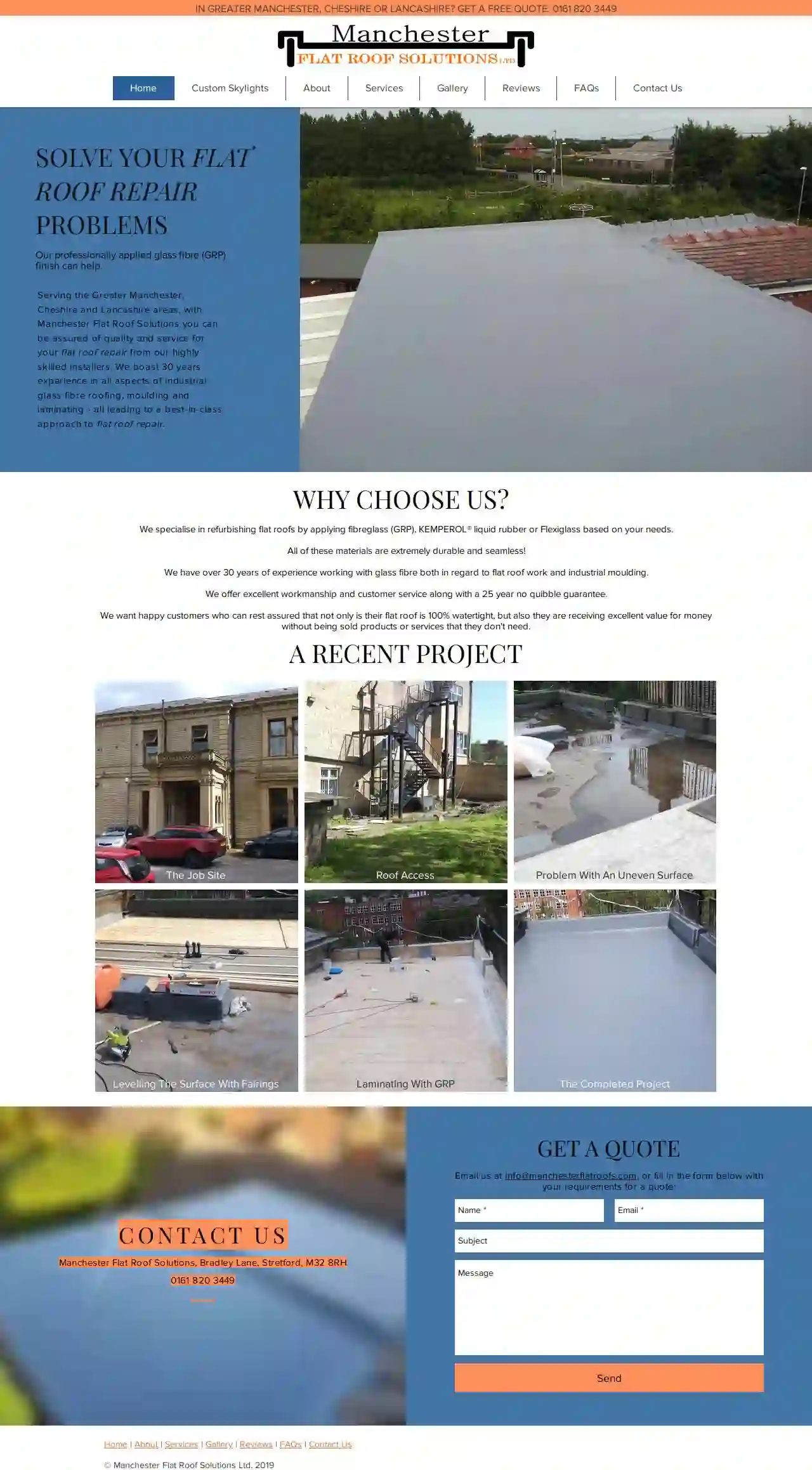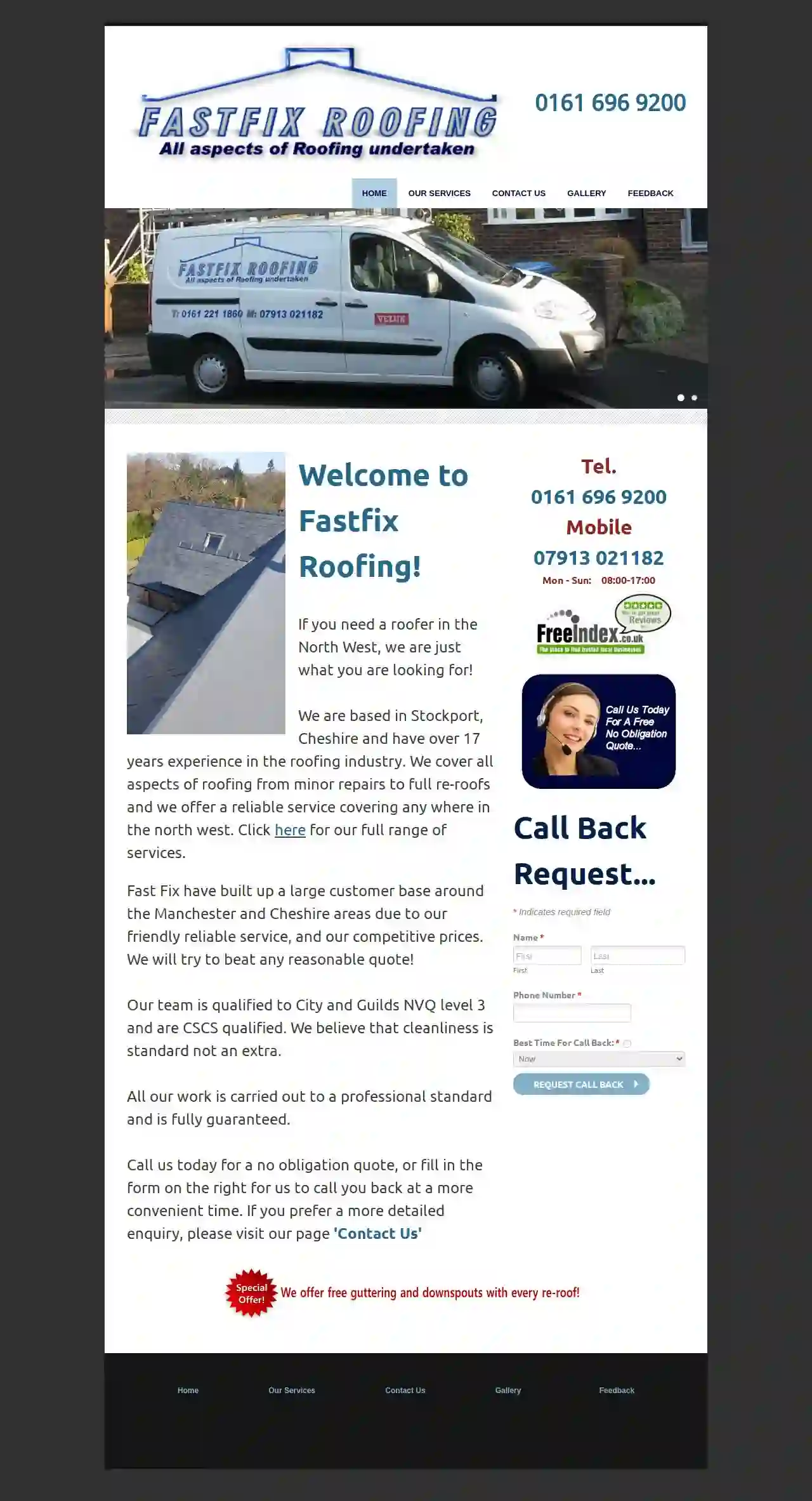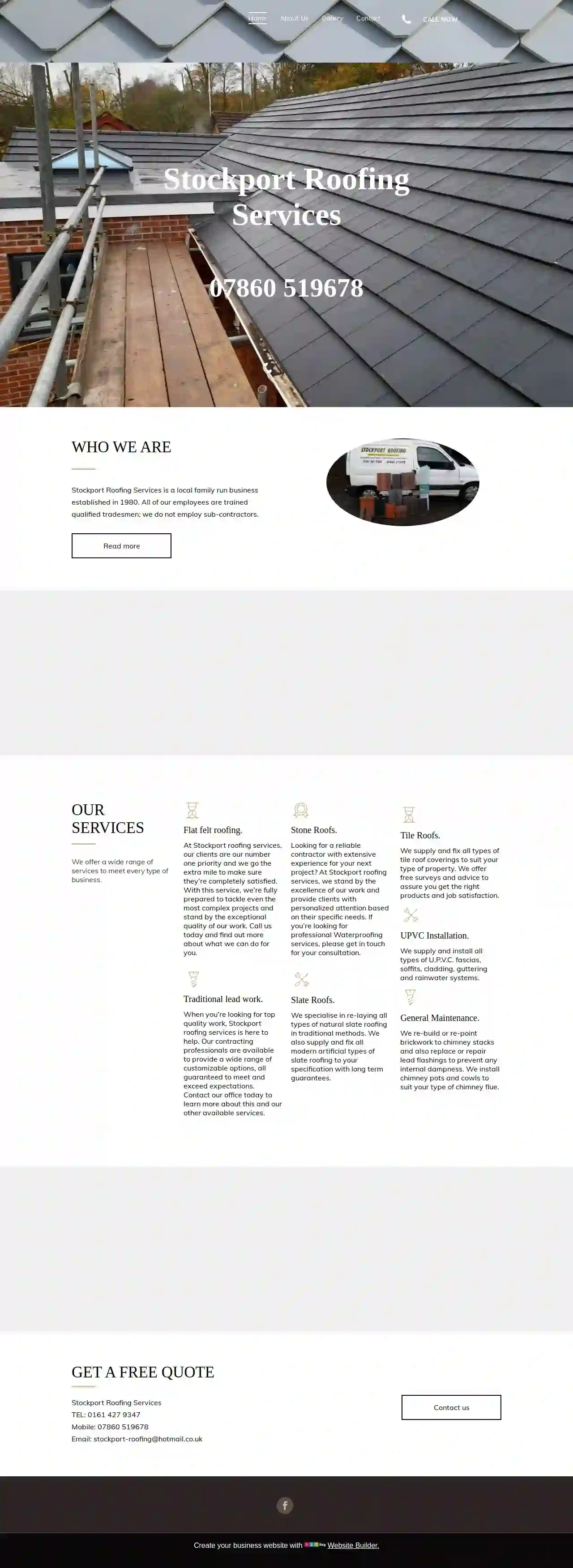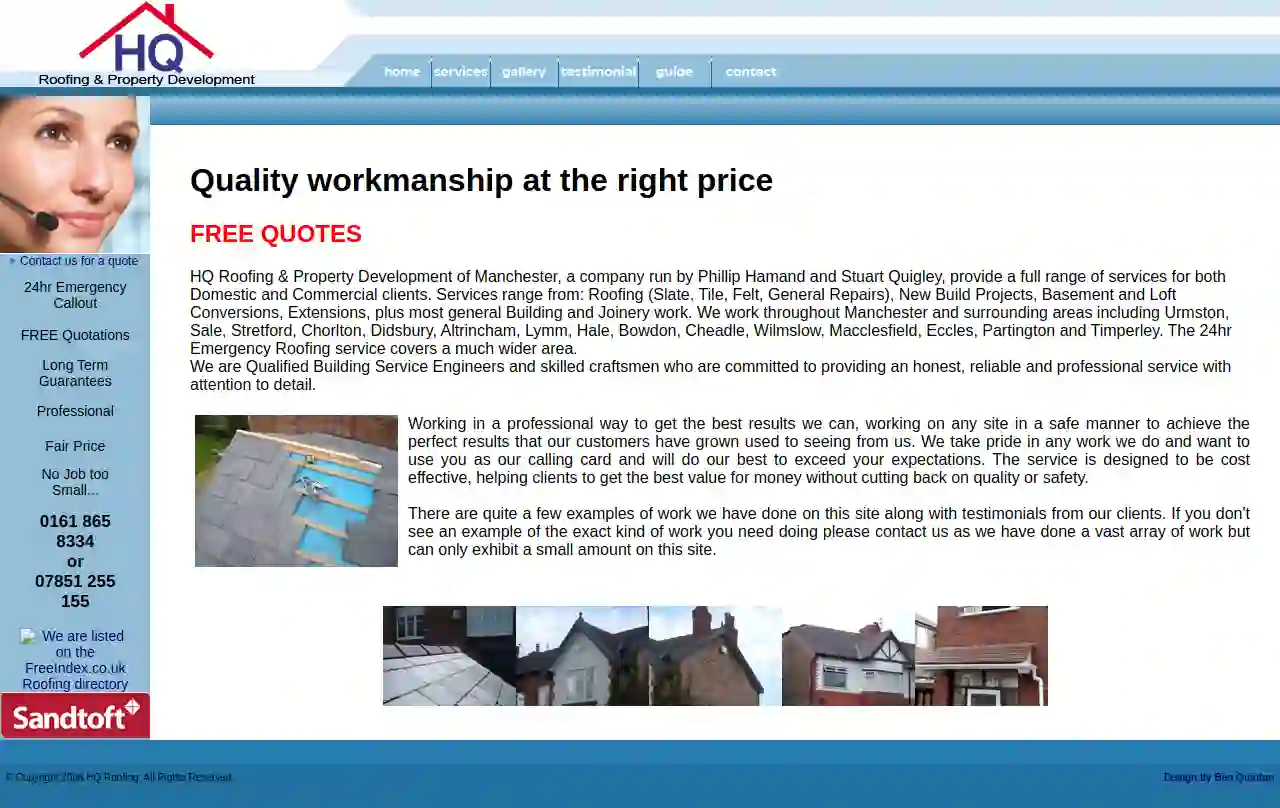Roofing Companies Hyde
Find Roofing Company in Hyde
Get multiple Roofing Service quotes for your project today! Compare profiles, reviews, accreditations, portfolio, etc... and choose the best offer.

Birchenough Construction
71 Fox Street, Stockport, SK3 9EL, GBAt Birchenough Construction, we are a trusted name for roofing and building services across Greater Manchester. We are a member of the Federation of Master Builders, and have been in the trade since 1972. We pride ourselves on our commitment to provide a professional and speedy service at all times, whilst maintaining the highest quality of work. Mark Birchenough has a proven track record of innovative design, effective problem solving and attention to detail and our goal is to meet and exceed the expectations of every customer. We are FENSA registered and also members of the Federation of Master Builders.
- Services
- Why Us?
- Accreditations
- Our Team
- Gallery
Get Quote
Manchester Flat Roof Solutions Ltd.
4.414 reviewsBradley Lane, Stretford, M32 8RH, GBServing the Greater Manchester, Cheshire and Lancashire areas, Manchester Flat Roof Solutions provides quality and service for your flat roof repair from our highly skilled installers. We boast 30 years experience in all aspects of industrial glass fibre roofing, moulding and laminating - all leading to a best-in-class approach to flat roof repair. We specialise in refurbishing flat roofs by applying fibreglass (GRP), KEMPEROL® liquid rubber or Flexiglass based on your needs. All of these materials are extremely durable and seamless! We have over 30 years of experience working with glass fibre both in regard to flat roof work and industrial moulding. We offer excellent workmanship and customer service along with a 25 year no quibble guarantee. We want happy customers who can rest assured that not only is their flat roof is 100% watertight, but also they are receiving excellent value for money without being sold products or services that they don't need.
- Services
- Why Us?
- Gallery
Get Quote
North West Lead Ltd
4.813 reviewsStockport, GBWelcome to Northwest Lead Ltd, a lead roof specialists company. We consistently deliver a high standard of work allied to a high degree of technical knowledge unsurpassed in the industry. We also provide the same expert service in the installation of copper, stainless steel, zinc and aluminium roofing and cladding with the associated carpentry and substrate works carried out by our highly skilled craftsmen. To complement our roofing skills Northwest Lead have the expertise to offer rainwater installations using traditional materials such as lead, cast iron and cast aluminium and contemporary installations using extruded aluminium, zinc, copper stainless steel and upvc. Northwest Lead Ltd are happy to assist with advice at design stage and see that advice through to completion of the project.
- Services
- Why Us?
- Gallery
Get Quote
Fastfix Roofing
4.651 reviewsUnit 3D, Mackenzie Industrial Estate, Bird Hall Lane, Stockport, SK3 0SB, GBWelcome to Fastfix Roofing! If you need a roofer in the North West, we are just what you are looking for! We are based in Stockport, Cheshire and have over 17 years experience in the roofing industry. We cover all aspects of roofing from minor repairs to full re-roofs and we offer a reliable service covering anywhere in the north west. We have built up a large customer base around the Manchester and Cheshire areas due to our friendly reliable service, and our competitive prices. We will try to beat any reasonable quote! Our team is qualified to City and Guilds NVQ level 3 and are CSCS qualified. We believe that cleanliness is standard not an extra. All our work is carried out to a professional standard and is fully guaranteed.
- Services
- Why Us?
- Accreditations
- Gallery
Get Quote
ARC Roofing Northwest Ltd (Stockport)
4.311 reviewsBredbury, 2 Weybourne Drive, Stockport, SK2 6DN, GBARC Roofing Northwest Ltd is a family-run roofing business with over 30 years of experience in the roofing trade. We offer professional roofing services to domestic and commercial customers in Stockport and the surrounding areas. Our skilled roofers are highly trained in all aspects of roofing, from complete re-roofing to minor roof repairs. We are established members of the Federation of Master Builders and Fair Trades, and offer guaranteed services at competitive prices. Our owner, Steve, will make a personal visit to your property to assess the work required and provide free quotes. We have a loyal customer base that has been growing over the years through client recommendations.
- Services
- Why Us?
- Accreditations
- Our Team
- Testimonials
- Gallery
Get Quote
Stockport Roofing Services
4.58 reviewsGBStockport Roofing Services is a local family run business established in 1980. All of our employees are trained qualified tradesmen; we do not employ sub-contractors. We have built our reputation on quality workmanship and service. We aim to give the best advice and the best service we can, whatever the budget. We will be able to quote very competitively from a large job all the way to a small one, with references supplied.
- Services
- Why Us?
- Gallery
Get Quote
KC Roofing
St James's House, Pendleton Way, Salford, M6 5FW, GBWe're a full service roofing company, which means you only need call one company for all your roofing requirements. No more searching online or through local trade directories to find an expert on slate replacement, or who can handle GRP fibreglass, or knows what they're doing when it comes to chimneys. From now on you've got the phone number for all the expertise you'll ever need. We're confident you'll not think that about us as we back our wide range of services with the professionalism and expertise to provide each one to the highest standards of quality. We're sure you'll be pleased just as many many others are in the area - in fact we guarantee it. There's a satisfaction guarantee on all work for your peace of mind. Roofing is our one and only business - we're not other tradesmen who dabble in it. We make it our profession and pride ourselves in work that will last for many years to come. The process starts with your first contact with us - we'll come and visit to assess properly what needs doing. We'll provide a full and free estimate that isn't full of extra and unnecessary work, and we won't sting you with any hidden extras: the estimate we give is a full price for the job. The tradesmen who will carry out the work for you are all fully experienced and trained professionals. We choose all staff carefully, and their customer focused approach means your experience of having us on your premises is as fuss-free and efficient as we can possibly make it. We're open and honest in our dealings with you. Along with full and free estimates, we don't try any strong arm sales tactics or scaremongering to force you into making a decision. There's no 'special offer but it only applies today' pricing - we'll show you what needs doing, provide a fair estimate and let you decide at your own pace.
- Services
- Why Us?
- Gallery
Get Quote
JCL Roofing Stockport Ltd
3.73 reviewsGBWelcome to JCL Roofing Stockport, specialists based in Cheshire that offer both homeowners and businesses across the Stockport area the very best in all aspects of roofing repairs and services. JCL Roofing Stockport have been established for over 20 years and have the experience and knowledge to provide our valued customers with the highest standard of workmanship, using proven methods and being approved installers of the Firestone EPDM rubber roof system. We take pride in being specialists in every aspect of roofing. JCL Roofing Stockport always provide a free no obligation survey, survey report and quotation.
- Services
- Why Us?
- Accreditations
- Gallery
Get Quote
Roofer Manchester . Com
Manchester, GBHQ Roofing & Property Development of Manchester, a company run by Phillip Hamand and Stuart Quigley, provide a full range of services for both Domestic and Commercial clients. Services range from: Roofing (Slate, Tile, Felt, General Repairs), New Build Projects, Basement and Loft Conversions, Extensions, plus most general Building and Joinery work. We work throughout Manchester and surrounding areas including Urmston, Sale, Stretford, Chorlton, Didsbury, Altrincham, Lymm, Hale, Bowdon, Cheadle, Wilmslow, Macclesfield, Eccles, Partington and Timperley. The 24hr Emergency Roofing service covers a much wider area. We are Qualified Building Service Engineers and skilled craftsmen who are committed to providing an honest, reliable and professional service with attention to detail. Working in a professional way to get the best results we can, working on any site in a safe manner to achieve the perfect results that our customers have grown used to seeing from us. We take pride in any work we do and want to use you as our calling card and will do our best to exceed your expectations. The service is designed to be cost effective, helping clients to get the best value for money without cutting back on quality or safety.
- Services
- Why Us?
- Our Team
- Testimonials
- Gallery
Get Quote
Roofcraft Roofing Services
574 reviewsBolton, 123 Main St, BL1 2AB, GBRoofcraft Roofing Services is a trusted Bolton Roofer with over 40 years' experience in all manners of roofing. From flat roofs to pitched, insulation to roof repairs, you won't find better roofers anywhere in the North West. We pride ourselves as being a leading roofer in Bolton and the surrounding areas, our prices are yet to be beaten and we have fantastic customer feedback. From your initial meet with our team, we give you a fantastic service to the very end of job completion. No job is too big or small. Roofcraft Roofing Services are friendly, efficient, reliable, and honest. Your roofs are safe in our hands!
- Services
- Why Us?
- Our Team
- Testimonials
- Gallery
Get Quote
Over 12,314+ Roofers in our network
Our roofing experts operate in Hyde and surrounding areas!
Roofyng.co.uk has curated and vetted the Best Roofing Businesses in Hyde. Find the most reliable business today.
Frequently Asked Questions About Roofing Companies
- Hot Climates: Opt for light-colored or reflective roofing materials to reduce heat absorption. Consider tile roofs for their thermal mass and heat resistance.
- Cold Climates: Ensure your roof has adequate insulation and ventilation to prevent ice dams and moisture buildup. Metal roofs can shed snow effectively.
- High-Wind Areas: Choose roofing systems with high wind ratings and properly installed hurricane straps or clips to enhance wind resistance.
- Areas with Heavy Rainfall: Ensure your roof has proper drainage and a waterproof membrane to prevent leaks.
- Asphalt Shingles: 20-30 years
- Metal Roofing: 40-70 years
- Tile Roofing: 50-100 years or more (clay and slate)
- Flat Roofing: 15-30 years (depending on material)
- Slate: 100 years or more
- Wood Shakes or Shingles: 30-50 years (with proper maintenance)
- Roof size and complexity
- Roofing material chosen
- Local labor costs
- Accessibility of the roof
- Removal of existing roofing
- Additional features (skylights, chimneys, etc.)
How do I choose the right type of roof for my climate?
How long does a roof typically last?
What is fascia, and why is it important?
How much does a new roof cost in the UK?
How do I choose the right type of roof for my climate?
- Hot Climates: Opt for light-colored or reflective roofing materials to reduce heat absorption. Consider tile roofs for their thermal mass and heat resistance.
- Cold Climates: Ensure your roof has adequate insulation and ventilation to prevent ice dams and moisture buildup. Metal roofs can shed snow effectively.
- High-Wind Areas: Choose roofing systems with high wind ratings and properly installed hurricane straps or clips to enhance wind resistance.
- Areas with Heavy Rainfall: Ensure your roof has proper drainage and a waterproof membrane to prevent leaks.
How long does a roof typically last?
- Asphalt Shingles: 20-30 years
- Metal Roofing: 40-70 years
- Tile Roofing: 50-100 years or more (clay and slate)
- Flat Roofing: 15-30 years (depending on material)
- Slate: 100 years or more
- Wood Shakes or Shingles: 30-50 years (with proper maintenance)
What is fascia, and why is it important?
How much does a new roof cost in the UK?
- Roof size and complexity
- Roofing material chosen
- Local labor costs
- Accessibility of the roof
- Removal of existing roofing
- Additional features (skylights, chimneys, etc.)